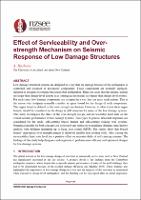Effect of serviceability and over-strength mechanism on seismic response of low damage structures
Abstract
Low-damage structural systems are designed in a way the earthquake damage is controlled and localised in pre-designated locations and components (e.g. fuses). These components are normally replaced, repaired or designed to remain functional when subjected to Ultimate Limit State (ULS) seismic actions. Nevertheless, experience from previous earthquakes demonstrated that seismic actions could be notably larger than design-level actions. Conventionally, the fuse components are designed with an over-strength mechanism to allow for higher strengths and larger displacement capacities to account for larger-than-design-level actions. However, how the over-strength mechanism should be designed and how much extra load and displacement capacities should be allowed for are different for different structural systems. So far, little effort has been made to answer these questions. Additionally, the severability requirements may directly or indirectly affect the over-strength performance of low-damage structures.
This paper investigates the effect of over-strength margin and serviceability limit state on the overall seismic performance of low-damage systems. For this purpose, two types of generic structural responses are considered for the study, self-centring systems with a flag-shaped load-deformation response and systems with a fully elasto-plastic response. Numerical models for both concepts are developed and subjected to dynamic analyses.
The findings of this study can help designers and engineers to perform more efficient and optimised designs for low-damage systems. Also, it gives a much better understating of the performance of such systems under large, rare earthquakes.

